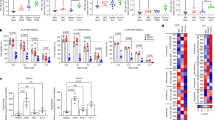Summary
Tumour necrosis factor alpha (TNFα) effectively stimulates the oxidative metabolism of human PMN in vitro. Moreover, preincubation of PMN with TNFα has been shown to result in an altered response of the target cells to subsequent stimulation. In the present study the response of PMN to stimulation in vitro was investigated in patients with metastasizing malignant melanoma receiving bolus injections of recombinant human TNFα as therapy. TNFα was given daily for 5 days. Blood samples were taken prior to TNFα administration on days 1 to 4 and on day 8. Lucigenin-enhanced chemiluminescence (CL) was used as a sensitive measure of granulocyte oxidative metabolism. PMN were stimulated with TNFα, TNFΒ, GM-CSF, PMA, opsonized zymosan and f-met-leu-phe. A significant increase in CL responses was detected upon stimulation with TNFα, TNFΒ and PMA from day 1 to day 3, whereas no significant changes were observed for the background activity or when GM-CSF or opsonized zymosan were used as stimuli. On day 4 all CL responses returned to the day 1 starting level. A further significant decrease was observed on day 8 upon stimulation with TNFα, TNFΒ and GM-CSF. In contrast, the effect induced by f-met-leu-phe reached a maximum on day 4, but the CL response was found to be at the starting level on day 8. The results indicate that TNFα induces significant changes in PMN response to distinct stimuli in vivo. Moreover, it may be possible that continous daily infusions with TNFα induce a hyposensitization of PMN oxidative metabolism.
Similar content being viewed by others
References
Conkling PR, Chua CC, Nadler P, Greenberg CS, Doty E, Misukonis MA, Haney AF, Bast RC Jr, Weinberg JB (1988) Clinical trials with human tumor necrosis factor: in vivo and in vitro effects on human mononuclear phagocyte function. Cancer Res 48:5604–5609
Ferrante A (1989) Tumor necrosis factor alpha potentiates neutrophil antimicrobial activity: increased fungicidal activity against Torulopsis glabrata and Candida albicans and associated increases in oxygen radical production and lysosomal enzyme release. Infect Immun 57:2115–2122
Kaplan SS, Basford RE, Wing EJ, Shadduck RK (1989) The effect of recombinant human granulocyte macrophage colonystimulating factor on neutrophil activation in patients with refractory carcinoma. Blood 73:636–638
Kapp A, Zeck-Kapp G (1990) Activation of the oxidative metabolism in human polymorphonuclear neutrophilic granulocytes-the role of immuno-modulating cytokines. J Invest Dermatol 95:94S-99S
Kapp A, Zeck-Kapp G (1991) Interleukin-5 induced granulocyte activation in atopic patients. Br J Dermatol (in press)
Kapp A, Danner M, Luger TA, Hauser C, Schöpf E (1987) Granulocyte-activating mediators (GRAM): II. Generation by human epidermal cells. Arch Dermatol Res 279:470–477
Kapp A, Zeck-Kapp G, Danner M, Luger TA (1988) Human granulocyte-macrophage colony stimulating factor: an effective direct activator of human polymorphonuclear neutrophilic granulocytes. J Invest Dermatol 91:49–55
Kapp A, Zeck-Kapp G, Blohm D (1989) Human tumor necrosis factor is a potent activator of the oxidative metabolism in human polymorphonuclear neutrophilic granulocytes (PMN) — comparison with human lymphotoxin. J Invest Dermatol 92:348–354
Kownatzki E, Kapp A, Uhrich S (1986) Novel neutrophil chemotactic factor derived from human peripheral blood mononuclear leucocytes. Clin Exp Immunol 64:214–222
Nathan CF (1987) Neutrophil activation on biological surfaces. Massive secretion of hydrogen peroxide in response to products of macrophages and lymphocytes. J Clin Invest 80:1550–1560
Nishizuka Y (1986) Studies and perspectives of proteinkinase C. Science 233:305–312
Ohsaka A, Kitagawa S, Sakamoto S, Miura Y, Takanashi N, Takaku F, Saito M (1989) In vivo activation of human neutrophil functions by administration of recombinant human granulocyte colony-stimulating factor in patients with malignant lymphoma. Blood 74:2743–2748
Porteu F, Nathan C (1990) Shedding of tumor necrosis factor receptors by activated human neutrophils. J Exp Med 172:599–607
Sullivan R, Fredette JP, Socinski M, Elias A, Antman K, Schnipper L, Griffin JD (1989) Enhancement of superoxide anion release by granulocytes harvested from patients receiving granulocyte macrophage colony-stimulating factor. Br J Haematol 71:475–479
Weisbart RH, Golde DW, Gasson JC (1986) Biosynthetic human GM-CSF modulates the number and affinity of neutrophil f-met-leu-phe receptors. J Immunol 137:3584–3687
Weisbart RH, Kwan L, Golde DW, Gasson JC (1987) Human GM-CSF primers neutrophils for enhanced oxidative metabolism in response to the major physiological chemoattractants. Blood 69:18–21
Author information
Authors and Affiliations
Rights and permissions
About this article
Cite this article
Kapp, A., Komann, A. & Schöpf, E. Effect of tumour necrosis factor alpha in vivo on human granulocyte oxidative metabolism. Arch Dermatol Res 283, 362–365 (1991). https://doi.org/10.1007/BF00371816
Received:
Issue Date:
DOI: https://doi.org/10.1007/BF00371816



